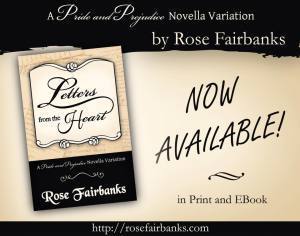L.L. Diamond's Blog, page 29
January 29, 2015
First Glimpse – An Unwavering Trust
It’s definitely just a peek, but for those wondering about my next book, you’ll get a little hint of part of it. There’s a lot more to it than what I have posted!
Darcy took a deep breath and exhaled, attempting to calm himself before he spoke with his sister. She tended to know enough of what was going on within Pemberley, and he did not wish to upset her with anything of which she was unaware.
Once he had tempered his anger, he made his way to her favourite room in the house and opened the door with care. He could not help but grin as he watched her brow crinkle at a more difficult passage while he silently closed the door behind him.
His thirteen-year-old little sister, Georgiana, had grown several inches since the last time he had laid eyes on her. She was tall for her age; her blue eyes and dark chestnut hair added to her stature, making her a striking young lady.
As he listened to her with pleasure, he realised how much she had improved. He waited until she released the last chord of the piece and clapped. She startled, visibly jumping up from the seat.
“Fitzwilliam! I had no idea you had come in! You nearly frightened me out of my wits!” He chuckled as she came around to embrace him. “You came in too late for me to greet you last night, and I know you are already planning on leaving us again.” She gave a small pout, prompting a bit of guilt for how little time he had spent with her, as they both took a seat upon a settee to one side of the room.
“I am sorry, Georgie. Sagemore is my estate—my responsibility—and it was necessary that I be there for the spring planting.”
She studied her fingers in her lap while he struggled to think of something to say that would help. The last thing he wanted to do was to tell her he might not be allowed to see her again. His thoughts were interrupted by the sound of her voice.
“I know, but I miss you when you are away.” Her gaze returned to his face, and she placed a hand over his. “Please tell me you are not going to capitulate to father’s commands.”
He sighed. “I do not see how I have any choice. He’s threatened to post an engagement announcement in the paper. People already question why Anne is not a part of London society. Could you imagine if I publicly jilted her?”
“Poor Anne,” commiserated Georgiana. “She is really a sweet person once you get to know her.”
“I know she is, sweetie, but neither of us wishes to be married to the other. If I defy father, you know I would not be welcomed back at Pemberley?”
Her eyes widened. “Did he say that?”
“Yes,” he said, nodding. “Which means that I would see you less than I do now.”
Rising from her seat, she paced back and forth for a minute before she abruptly turned to face him. “I would not have you sacrifice your happiness for me. One day you may resent me for it.”
“I could never resent you!” he cried, rising to his feet.
She shook her head and he could see the tears welling in her eyes. “You must do what makes you happy, Fitzwilliam. Neither you nor Anne would be happy in that marriage. You should find someone and marry her before father can announce the betrothal.”
He laughed and returned to his seat. “You want me to find someone and wed within a fortnight?”
“Why not?” she exclaimed. “Would it not solve the problem for both you and Anne? A betrothal announcement for someone who is already married would not be taken seriously by anyone.”
“Father would never allow me to return to Pemberley, and we would likely not be in company again until you come out or are wed yourself.”
“But we can write letters,” she said in a hopeful tone.
“You do not think he would prevent that?”
She waved her hand dismissively. “Mrs Reynolds and Taylor sort the post before he sees it. I doubt he would ever know.” She wore a wide grin, and he worried what thought had come to her mind. “Even if he did, you could have Grandmamma send them inside hers.”
“He blames Grandmamma for my refusing to go along with his wishes. He could attempt to sever your relationship with her as well if I openly defy him.”
She snorted. “As if she would ever allow that!”
Chuckling at something so similar to his own opinion coming from her mouth, he grinned while she took her seat once more. “So I am to find a bride in a fortnight? That does not sound like it would bode well for my felicity.”
“When you put it like that, Fitzwilliam, no…it does not. But what if happiness in marriage is entirely a matter of chance? If the dispositions of the parties are ever so well known to each other, or ever so similar beforehand, it might not advance their felicity in the least. Perhaps it is better to know as little as possible of the defects of the person with whom you are to pass your life.”
He regarded her sceptically and she shrugged with a smile. “Or perhaps Grandmamma will have an idea. You will just have to think hard during your return to London.” She reached forward and grasped his hands. “You secure your happiness, and Anne’s, and one day, perhaps Father will come around.”
“I will consider what you have said, but I think you are mistaken when it comes to our father.”
“You shall not take my hope away.” Tears welled in her eyes again, one dropping on to her rosy cheek.
“I would never wish to, Georgie.” He reached over and pulled her into an embrace. “I have no idea what the next fortnight will bring, but no matter what father says, please remember that I love you, little sister.” Her shoulders shook and she released a small sob.
“I love you, too.” She pulled back, her tear-covered cheeks breaking his heart. “I understand what will happen, but please do not marry Anne merely because you feel you have no other choice.”
“Do you really think she would enjoy being jilted?”
Georgiana shrugged. “She has no wish to ever marry, so she might appreciate the scandal. You know that Grandmamma, Uncle Henry, and Aunt Elinor would ensure society knew the two of you were never truly betrothed. I doubt she would suffer any more than she does living with Lady Catherine.”
“Behave, Georgiana,” he scolded.
“You act as though you do not agree.” Her tears had stopped, and she had perched her hands on her hips.
“I may agree, but I do try not to say it.”
She giggled and reached over to hug him once more. “You should go before father finds you are still here.” Nodding, he pulled back and placed a kiss on her forehead.
“I will expect a letter from you at Grandmamma’s soon after my arrival.”
He pulled away and left before he lost control of his emotions, hearing Georgiana’s faint “Goodbye, Fitzwilliam” before the door closed behind him.
I’d be happy to hear your thoughts! Tell me what you think!

January 27, 2015
Sources of Inspiration – Artists as Modistes
Are the characters in your favourite novels only fictional places in someone’s mind, or is there a corresponding place or inspiration? I am beginning this new installment as a way of allowing you a bit of insight into my mind, as long as you aren’t terrified at the prospect! ;-)
Today’s post gives you the inspiration behind the names of the modistes in my novels. If you’ve read historical fiction, then you are likely aware that a modiste was a dressmaker. Women made appointments with the modiste and then searched through fashion plates as they made their orders. It seems many authors use French names for the women in this occupation, and I followed that trend; however, rather than make up names, I derived their actual names from French female artists.
A modiste likely took nips and tucks to fabric to create the perfect gown as artists in history added extra brush strokes to their canvases to create the perfect landscape or portrait. I felt it an appropriate parallel.
Just to give a bit of history, until the 20th century, women often were overlooked as artists. Mediums common to women (watercolor, paper cuttings, etc.) were classified as craft rather than fine art, and their was even a hierarchy of genres, which, believe it or not, was a list of what paintings were considered more important than others. This list made it even more difficult for women to succeed in painting.

The Academicians of the Royal Academy, London. 1771-72 Johann Zoffany
For example, the most respected form of painting was histories. If you consider that genre, these included mythology, religion and allegories. For centuries, women were not allowed to study the human form (primarily the male nude form), so how were they to paint these scenes without the proper training and study? In this portrait of the Royal Academy, painted in 1771-1772, the members of the group are sketching a male model. Two women belonged to the Royal Academy during this time, but if you’ll examine the painting closely, they do not appear at first glance; however, if you look closer, you will see both Angelica Kauffmann and Mary Moser are in portraits hanging from the wall behind the model. Women were mostly relegated to the periphery as far as training and recognition.
Just for reference, this is a listing of the hierarchy of genres to let you know where these women made their names.
Histories (includes religion, mythology, and allegorical subjects)
Portraits
Genre Paintings (paintings of daily life)
Landscape
Animal Painting
Still Life
I see the use of their names as a subtle nod to them and their work. So, without further ado, please allow me to introduce you to the artists.
Rain and Retribution
Madame duParc

Seamstress or Young Lady Sewing
Françoise Duparc (1726-1778)
Daughter of sculptor Antoine Duparc, she did not become well-known, even within her own country of France, until the beginning of the 20th century. Duparc did not sign or date her works, so many of her paintings are unknown with the exception of four paintings she bequeathed to the Musee des Beaux-Arts in Marseille. The works she is known for are all “genre portraits.”
An Unwavering Trust

Self-portrait of Elisabeth Vigee-Le Brun
Madame Lebrun
Élisabeth Vigée-Lebrun (1755-1842)
Élisabeth Vigée-Lebrun found amazing success during her lifetime as a court painter for Marie Antoinette. A child prodigy trained by her father, over a ten-year period, she painted 30 portraits of the French Queen. She even painted several famous depictions of the monarch with her children prior to the French Revolution.
Due to her fear of the coming revolution, she fled France with her daughter in 1789 and traveled to Austria, Czechoslovakia, and Germany, painting the nobility and aristocracy, before travelling to Russia, where she remained for six years again painting portraits of the aristocracy and the Russian royal court. Prior to her permanent return to France in 1805, she spent almost two years in London.
The painting shown is a self-portrait. I recently had the privilege of viewing a copy she painted that hangs at Ickworth near Bury St. Edmunds. It is a stunning work!
Untitled work-in-progress

Portrait of Rosa Bonheur by E.L. Dubuque
Madame Bonheur
Rosa Bonheur (1822-1899)
Rosa Bonheur, like many early female artists, trained under her father, and by the age of 23, had already exhibited 18 works in the Paris salon—an impressive feat for a woman during that time, especially considering her subjects were animals sometimes within a landscape.
Bonheur separated herself by not only being an artist, but by her research. She was known for frequenting the slaughterhouses where she studied in-depth the anatomy and musculature of the animals she painted. It was said she even had a license to wear pants (Yes! She had to carry a license just to wear trousers!) since it was impractical to wear skirts as she made her studies.
The painting below, Le Marché aux Chevaux (The Horse Fair) established her within the international art community, and even provided her the opportunity to tour London with the work.
I hope you enjoyed this little foray into my thought processes and perhaps gives you some inspiration to learn more about one of these amazing women. If you have a favourite French artist, then please tell me in the comments below. If she fits, perhaps I’ll use your suggestion the next time I require a name!
Bibliography
Gaze, Delia. Dictionary of Women Artists, J-Z. Taylor & Francis, 1997. (p. 475)
http://www.biography.com/people/elisabeth-vig%C3%A9e-le-brun-37280#travels-after-the-revolution
http://www.arthistoryarchive.com/arthistory/realism/Rosa-Bonheur.html
http://wikimediacommons.org (paintings)

January 23, 2015
Winner of the Letters from the Heart Giveaway!
who contributed questions and comments
for Ask the Author this month!
I’d like to give a special thanks to those repeat offenders out there who have been contributing questions or comments on every interview. Y’all are awesome!
Without further ado…
Winner of the Letters from the Heart e-book is
Carol Hoyt!
Congratulations Carol!
Next month’s Author is Zoe Burton,
author of I Promise to…
Call for questions posts is February 2! Stay tuned!

January 20, 2015
Norwich Cathedral
Origins of the city of Norwich were long ago. At the time of the Norman conquest, Norwich was already one of the largest towns in England with the Domesday Book (1066) mentioning it had twenty-five churches and a population of between five and ten thousand. The Normans changed the town by building the castle and then in 1096, beginning the cathedral.
As with many of these old English cathedrals, the construction was a long process and often only the beginning. The Norwich cathedral was completed in 1145 A.D and contains a combination of Gothic and Romanesque architecture–what they call ‘Norman architecture.” There have been additions and parts rebuilt since, but the original chapel still stands.
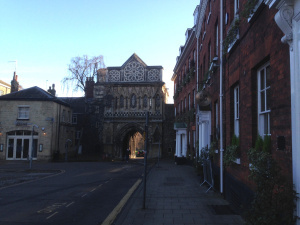
Entrance to Cathedral grounds
For such a large town, Norwich has a quaint, homey feel. We were unsure of parking near the cathedral, so we found a car park as close to the town centre as possible and walked the remainder (only about a mile). From the direction we approached, the cathedral grounds are surrounded by a wall. Once you enter the tunnel (be careful for cars!), the cathedral is just across a small green space.
The entirety of the complex is large, and part of it has been modernised to keep up with the times, but I loved how they added to the cathedral without harming the original structure. I passed through the cloisters to find the water closets, and they had added a glass wall with doors to one side of the cathedral wall, that wall becoming one side of the hallway. There were signs asking people not to touch the original stonework due to its age.
The cloisters and courtyard are amazing! I love the old arches and architecture.


 The inside of the cathedral was even more amazing! We travelled there to attend a Sunday morning
The inside of the cathedral was even more amazing! We travelled there to attend a Sunday morning
service near the Epiphany with a friend of mine. She was a part of a tour that journeyed to several churches and cathedrals around England for services and Evensong services. The service was beautiful! The choir was incredible and they have the most incredible pipe organ! The sound filled the interior of the chapel with ease. Going to services within such splendid surroundings was worth the trip in my opinion.
I have noticed these old churches and cathedrals are a bit draughty, most people wear their coats during services, but I didn’t notice the cold as much that day. I do not know if it was just so many people that the chapel was warmer, or if I was enjoying the service and architecture so much it was a distraction.
 The vaulted ceiling is like a fan vault except it is called a Presbytery Vault. They’re difficult to make out in the picture (sorry!), but the small knots are actually sculptural elements. The parts going down the centre of the ceiling are representative of the books of the Bible in order with one larger, red element representing the parting of the Red Sea. Before the service and after, I would find myself staring. The ceiling is amazing and I’m sure a huge expense in maintenance.
The vaulted ceiling is like a fan vault except it is called a Presbytery Vault. They’re difficult to make out in the picture (sorry!), but the small knots are actually sculptural elements. The parts going down the centre of the ceiling are representative of the books of the Bible in order with one larger, red element representing the parting of the Red Sea. Before the service and after, I would find myself staring. The ceiling is amazing and I’m sure a huge expense in maintenance.
(Each of these cathedrals has a huge bill for keeping these old structures in working order, and I’m certain with the high ceilings, to heat in the winter. This cathedral’s bill is a whopping £,4000 per day-that’s approximately $6,400 U.S. dollars/day!)
The stained glass windows in the Norwich cathedral are stunning, although I was told by my friend they do not date as far back as the chapel and were built and installed during the Victorian Era.
The Norwich cathedral is the second I’ve entered since arriving in England, and they’re worth the trip, in my opinion. One cannot but be impressed at the architecture and the artistry involved in these buildings-especially when you consider their age. The time involved in rendering the minutest of details is mind-boggling to me.
http://www.cathedral.org.uk/historyheritage/architecture-the-cathedral.aspx
http://www.wikipedia.org

January 19, 2015
Rose Fairbanks Ask the Author Interview is in!
This month’s victim guest is Rose Fairbanks
Rose is the author of The Gentleman’s Impertinent Daughter,
and the just recently published Letters from the Heart.
Blurb from Amazon.com – “Resolved to forget Elizabeth Bennet during a winter in London, Fitzwilliam Darcy writes a letter in bitterness of spirit. Frustrated by her growing obsession with the arrogant man, Elizabeth commits her thoughts to paper. But angry people are not always wise, and secret thoughts do not always remain secret. Compelled to face their selfishness and fears, their actions encourage those dearest to them to change as well.”
Hi Rose and welcome to your first Ask the Author! Thanks for offering to be one of our victims and for offering the giveaway of your new book, Letters from the Heart!
We received some great questions so without further ado, let’s get to it!
How many times have you read Pride and Prejudice?!
(sophieandmomma)
Oh, dear. Well, it was a few times in high school and then at least once a year in college. Then after college I just continually went in a little circuit of Austen books but didn’t do it fairly and read P&P more than the others, especially once I had a nook. Austen’s Complete Works was the only book I had on there for well over a year. Then once I found JAFF I would reread it between every book or two for the first few months. Now as a writer I’m constantly rereading scenes. My guess would be between 50 and 75 reads.
What author of Jane Austen´s fan fiction do you prefer and why? (Apart from your own work ☺)
(Ana MR)
It’s impossible to pick just one! I found Sharon Lathan’s books first. Then Abigail Reynolds’. Looking at my Kindle and Nook books I’ve got nearly everything by Linda Wells, Kara Louise and Wendi Sotis and reread them often. I also love both published stories by our lovely host, Leslie. I also love being a beta reader for Sarah Johnson and Zoe Burton. I get to read their stuff before anyone else! :P
What draws your inspiration to write?
(Dung Vu)
Most of my story ideas come from wondering how the story would be different if something else happened in a particular scene. Somewhere along the way I usually consider a personality trait to highlight as well.
Are there specific scenarios that you have not seen written that you felt compelled to share to readers?
(Dung Vu)
Hmm…I don’t think any of my overall scenarios are entirely unique. I’m not sure that’s possible anymore. JAFF has been around for a number of years, there’s loads of it published, even more for free online and the writing isn’t slowing down anytime soon it looks like. But I think everyone brings something different to the table. My first two stories were from a shared prompt. Anyone could have began a story with a similar idea. The next two long ones both stem from the idea of a forced marriage but I specifically wanted them to not be full of despair and I think they turned out very different from each other.
How do you manage to keep the essence of the characters as you write your book?(sophieandmomma)
I do compulsively read Canon scenes while writing. I’m constantly trying to get more in their head. I look at Elizabeth’s statement to Darcy when he asks her to dance a reel at Netherfield and she says she delights in overthrowing the schemes of people who would mock her taste and wonder if this is something she’s come in contact with a lot. How does that affect how she meets with others? And is that so different than Darcy considering others only want to use him?
I also have excellent betas who are very protective of the characters. I’m writing a story right now where Bingley leaves Netherfield on his own volition. So I asked two friends who are Bingley fans to read it for me, to be sure I’m not too crazy with him. If I tried to write alone I’d never finish anything!
How do you keep your books fresh? By that I mean not incorporating ideas from other authors ?
(Carol Hoyt)
As I said above, I’m not so sure anything is entirely unique. If I know my idea comes close to a certain topic in a book I’ve read then I avoid rereading that one so it doesn’t consciously spill over. And I freak out and ask my betas a lot. In the last story I wrote, I reread two different old favorites and their premises weren’t close to mine at all but there were events that were and I had to talk to my betas and have them compare the scenes and how they worked for the story. There are times when it is really difficult to be intentionally different, though. Wickham typically presents a problem. There seems to only be a few variations of what he does and how he’s dealt with. I have certain favorite things to do with him but then I worry about repeating myself too much!
What motivates you to keep writing? Sales? Reviews? Stories that are just begging to be written? A pushy family member?
(Joy Dawn King)
I was writing long before I ever thought about publishing. I started writing fan fiction after only a month or two of reading but never thought I’d share those stories. I never finished them and looking at them now they’re terrible. But I had ideas that needed to get out. I really like asking the question “what if…” As for publishing them, I think they’re good. When I was only a reader I was so obsessed I read a lot of bad things and would have been happy to see another book out that didn’t have horrible errors or terrible story telling. And I didn’t know about the forums, but even now I reread purchased books more- even when they’re also online- because the formatting is more convenient. I feel like those readers should get a chance to read something good too.
What has been your biggest surprise since publishing?
(Joy Dawn King)
Publishing is a roller coaster of emotions. I started with my novellas before my novel (coming this Spring) because I didn’t know if I could really handle the reviews or even the hard work of having it all come together. I had posted stories online so I thought I was prepared for reviews. It’s a little different, for example you don’t reply back to reviews and they’re total strangers. It’s not a community. The other unexpected thing was all the steps of the book cover. I had thought it was as simple as picking a picture or two I liked! But they both are beautiful and worth the extra time and all my graphic designer’s effort.
Out of 100% – how much is writing? how much is reading? how much is watching? How much is research? Did I forget anything?
(Joy Dawn King)
Actual writing is probably only 30% of my time, especially as I have gotten better about plotting ahead of time. By the time I sit down at the computer a lot can come out at once. I do reread scenes from the original with nearly every writing or plotting session. Research also takes up a good bit of time. More so because I intensely enjoy it than the fact that my stories are that detail oriented. I don’t actually watch the media too often and it’s nearly entirely for pleasure. I did use the train station kiss from the North and South TV series for inspiration in Letters from the Heart so I watched that scene several times.
You forgot the bane of my existence: editing! I have awesome editors. The easy part is clicking “accept all” to their suggestions for sentence structure or corrections in grammar and punctuation (I will never understand commas). The harder part is when they need more or less information or find something I’ve grown attached to as superfluous. But pruning is necessary and the story is always better for it.
In your dream JK Rowling moment, what is the one thing that you would love to have happen because of your writing?
I need to stop before I become as ridiculous as Mr. Collins. Ok – maybe too late.
(Joy Dawn King)
I’m actually uncomfortable with praise, but seek validation. I don’t necessarily need it from the world at large, but if I think well of the person then I would love it if I was deemed insightful and told that my story made someone smile.
I need to know. NEED to know. Where the heck do you find the time and energy, woman!? Wife, mother, blogger, reviewer, and self-published author (which is a full time job in and of itself.) I’m amazed … and frankly jealous. LOL ☺ You must have the blood of a four-year old coursing through your veins. You go girl!
(Cat Gardiner)
I don’t sleep very much! I have an awesome husband who lets me spend the majority of his days off doing JAFF things and I work on it nearly every evening too. During the day, if the inspiration is striking and I have a few minutes I’m writing something down. But honestly? I’m not so sure I do any of these things particularly well. I don’t review near as much as I’d like to (despite the fact that I am still reading when many authors have to choose between the two), nor do I have routine blog posts. My goal in 2015 is to do better with both. I like to do lists and break them down into small tasks with goal dates.
Are there any specific challenges being an author or publishing your books that you wanted to share?
(Dung Vu)
Self-publishing doesn’t have to be a lonely endeavor. I’ve got good editors and resources for things like covers and formatting or any other concern. It can be really intimidating opening your book up to the world at large and there are a lot of different factors in people’s tastes. What gets me through those moments is knowing that I and many others really liked the book and put a lot of effort into making it a good and worthwhile read. You can’t suit everybody. And if one person loves it, another person will hate it. In the end, make yourself happy with it. And with self-publishing I don’t have a “well, I wanted to do *this* but the editor said no” moment.
What specifically was your inspiration for Letters from the Heart? Were you looking to write a sort of forced marriage scenario or was it something else?
The very first draft was a writing prompt from an online forum. There were several “wacky holidays” and one was “letter writing day.” It also had a word count limit. So the premise of Darcy and Elizabeth writing letters to each other came from there. Logic followed that if they’d ever become known it could be a forced marriage scenario but that was a very small concern in the first drafts. In the online drafts, Elizabeth does not refuse Darcy and it all wrapped up very quickly. When I edited it for publication I spent a lot more time with the characters and felt like if I wasn’t just telling myself it had to be a short story with only a certain amount of words, then the characters would work things out differently.
As a book reviewer, you’ve been critiquing books for quite a while now. How does that affect your writing? Does reading a well-written book give you inspiration? For example, if you read an author who excels at humor or descriptions, do you find yourself attempting to improve your skills in those areas?
There are some things that don’t come naturally to me very well, humor is one of them. I struggle with showing a witty Elizabeth and fear what appears witty to me doesn’t for others. But I try to consider other things, like narration style. My favorite JAFF is first person narration, Elizabeth’s point of view. I’d really like to do that one day. Another favorite is third person, but we only get Darcy’s point of view. I’ve tried that a few times and have failed at it. One of these days I’ll get it right. I’m also more critical of storytelling in general. I’ve recently read a book with several “go no-where” tangents and it annoyed me to no end. They made me ask more questions and they were never answered by the author. I actually struggle to make my stories long enough because I prefer to write without adding unnecessary things. That’s something I worried about in Letters from the Heart. Thankfully, I was able to link the other characters to Darcy and Elizabeth rather well, I think.
Do you have any current projects in the works? If so, what can you tell us about them.
I’m in the middle of editing a full length novel for publication this spring. No Cause to Repine begins when Darcy calls on the Parsonage alone. He trips over the rug and lands on Elizabeth just when several people are shown into the room. Between Mr. Collins and Lady Catherine the situation is made into a more compromising event than it was. Forced into an engagement with unequal affections and soon met with an unexpected obstacle, Darcy and Elizabeth must together find a path that leads to no regrets.
I am also part of a boxed set of novellas which will release April 1. I haven’t settled on a title yet! Elizabeth overhears part of Darcy’s conversation with Caroline as the two were walking outside of Netherfield. Left with the realization that Darcy admires her, Elizabeth determines to quit antagonizing him, or so she tries. Believing if she spurns his attentions the proud man will leave Netherfield—and likely take his friend too—she bears with his presence for Jane’s sake.
I have a number of other pieces that will eventually be published and several others that I am currently writing and will one day finish up on my blog: http://rosefairbanks.com
So, now the giveaway!
Rose has graciously offered an ebook of Letters from the Heart!
Everyone who submitted a question has their name submitted one time in the draw. Now, everyone who comments on the finished interview gets their name entered–for those who have already submitted a question, that means your name goes in twice if you comment! Those who only comment get their name entered once, so COMMENT! Any chance is better than none!
Final comments to be entered into the drawing Wednesday, 21 January.
Winner will be announced Friday, 23 January.
Thanks so much to Rose for being our guest and please leave her a comment
to let her know
you enjoyed learning more about her!

January 13, 2015
Fitzwilliam Museum, Cambridge
Cambridge is, of course, well-known due to Cambridge University and the various colleges scattered around town, but one might not realise the colleges have affiliated museums that are worth the effort to view if you are in the area.
Due to a spot of bad weather, we decided to make the drive down to see the Fitzwilliam Museum. The Fitzwilliam Museum is the arts and antiquities museum of the University of Cambridge, and the lead of the University of Cambridge museums consortium. A major perk–Admission is FREE! Yes, free.
As an art lover, I have gladly paid admission to art museums for the privilege of viewing the treasures within, but I was even more excited at the prospect of a free day at the museum. They do ask for a donation, and we gladly contributed to help with their costs.
The first time we came upon the Fitzwilliam Museum, we turned a corner in an attempt to find a car park and everyone in the car said, “whoa!” at the view. The exterior is a large and impressive Palladian influenced building with Corinthian columns, pilasters, and classical style pediment. It dwarfs every other building on the block with its size and architecture.
While the museum itself was founded in 1816, the initial building, completed in 1845, was called “The Founder’s Building” and designed by George Basevi and completed by C.R. Cockerell. The entrance hall was completed in 1875 by Edward Middleton Barry.
The view of the ceiling before you enter is beautiful and was an unexpected stop to gawk before I entered the door.

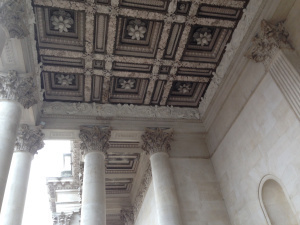
Just after you enter, the hall is beautiful. A great dome (I wish my photo hadn’t been blurry!), stone columns, insets for statuary, and a large staircase are stunning and give a rich appearance in contrast to the simplicity of the colours in the remainder of the museum.
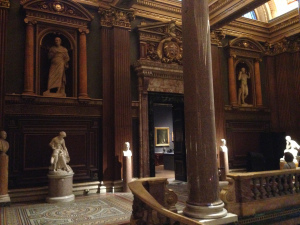
We began our trek through the ancient art exhibit and worked our way through. While they were not extremely large exhibitions, the content made the displays impressive. We wended our way through Egypt, where we viewed several sarcophagi, a mummified kitten, and various stonework and hieroglyphs to Greece, featuring pottery from each period of Greek history, statuary, and coins.
One of my favourite parts had to be the Cycladic figurines. We went into an in-depth study in an art history class (Bronze Age in the Aegean) and to see not just one but two of the small white figures was awesome! They were also each from different time periods, which could be determined from their shapes and a few slight variations in their compositions.
Anyway! If you get me going on art, I could ramble on for days!
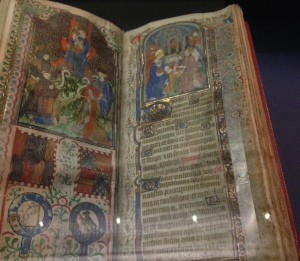
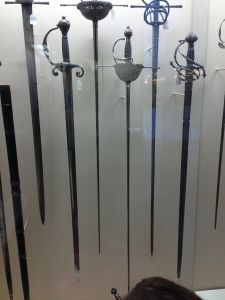
At the time of our visit, the museum had several special exhibits, including one on Goya, a modern art exhibit featuring mannequins called Silent Partners, and an exhibit of prints by Caroline Watson and other female artists. (I hope to do another write-up on Caroline Watson sometime, so I won’t elaborate too much here!) Due to the children and the content of the exhibits, we did not tour the Goya or the Silent Partners exhibits, but I do recommend the Caroline Watson exhibition if it happens to travel to a gallery near you. It’s wonderful!
Over the course of a couple of hours, we rambled through the ancient art, medieval, weaponry and armour, the printmakers, and the Dutch masters before we decided to save the rest for a return trip. I could spend all day, but I have children, who after a time, decided they were hungry. There is something to be said for returning to fight another day rather than beating a dead horse!
I look forward to returning to the Fitzwilliam Museum, and if you happen to be in Cambridge and are looking for a day of fine art, then I highly recommend the experience!
(If you intend to visit and take photos, please consult the museum’s rules on photography. I was relegated to the use of my phone due to their regulations.)
Next up – Service at the Norwich Cathedral

January 12, 2015
Ask the Author with Rose Fairbanks
Now that everyone has made their New Year’s resolutions and become settled in their new year’s routines, it is time for a new Ask the Author!
This month’s victim guest is Rose Fairbanks
Rose is the author of The Gentleman’s Impertinent Daughter,
and the just recently published Letters from the Heart.
Blurb from Amazon.com – “Resolved to forget Elizabeth Bennet during a winter in London, Fitzwilliam Darcy writes a letter in bitterness of spirit. Frustrated by her growing obsession with the arrogant man, Elizabeth commits her thoughts to paper. But angry people are not always wise, and secret thoughts do not always remain secret. Compelled to face their selfishness and fears, their actions encourage those dearest to them to change as well.”
But wait!!! Rose is offering one e-book of Letters from the Heart as a giveaway! Usual rules apply – Every person who submits a question gets one chance entered into the pot. If you submit a questions and comment on the final interview you get two chances!
I hope everyone will welcome Rose with a question or two!
All questions must be submitted by Friday, 16 January.
The final interview will be posted Monday, 19 January.
Final comments to be entered into the drawing Wednesday, 21 January.
Winner will be announced Friday, 23 January.

January 3, 2015
Colchester Zoo
Yes, the zoo! As much as I’d love to do nothing but a Jane Austen tour of the UK, my children would likely rebel!

My husband had what was to him a great idea a few weeks back. We should go to the zoo! In the days prior, I did express some concern as to the weather forecast. While it was supposed to be a beautiful sunny day, the high where we live was 37ºF (3ºC). He insisted that the high was 40ºF at the zoo, and with the sun we should be fine. I will say it was still a bit cold for my taste!
Aside from the cold, the zoo is lovely. There is a stream that passes through the centre, lots of buildings where you can view the animals (It would have been nice to have some of them heated like in Nebraska!), and lots of animals. A few we could not see due to the cold and humidity. There was a great deal of condensation on some of the windows, especially with the large cats, but I would not expect any of the keepers to run inside to squeegee the glass so we could see.


The atmosphere is nice. There are snack places where you can get hot chocolate and other warm drinks, which was nice. My only complaint of the day was at lunch. I wish I’d brought myself more gluten-free options. I’ve been pretty lucky that most National Trust homes at least offer a soup with a gluten-free roll. Apparently, the zoo usually has a potato (I’m assuming baked potato, called a jacket potato here) because the kid asked about whether they had any. In the end, I had the usual choice of one soup with a gluten-free roll. I’ll just say that I’m not a big lentil fan!


One of the neatest parts was a ruin of an old church in the middle of the zoo. We had noticed a house covered in vines near the food court area, but hadn’t realised the house had been part of an estate that was on that land in the past. The ruins still had arched windows and supports in the tower. I think I must have been really excited when I saw it because we went with friends who chuckled as I snapped a bunch of photos.
So, the skinny if you decide to give the Colchester Zoo a shot. It’s nice and definitely worth seeing. Make sure you check the activities of the zoo because we didn’t realise there was an extra admission when we went. During Christmas, children can visit with Mother and Father Christmas, who give the child a gift and you can take a photo. It was a nice treat, but we weren’t prepared for how high the tickets were when we arrived. It was a bit of a shock. In the end, I’d recommend a warmer day, and if you do go during the Christmas season, I recommend Mother Christmas–she gives better gifts!

Christmas Craft Fair at Wimpole Hall
A few weeks ago, a friend and I ventured out to Wimpole Hall for my first English Christmas Craft Fair. I’ve heard fairs in some towns are larger, but I did enjoy this small event. I had wondered if the fair would be cancelled when it was foggy and wet that morning, but we swiftly discovered everything would continue as planned–They had brought in a tent to keep us and everything nice and dry.
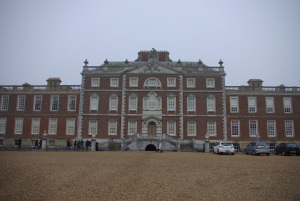

The fair itself had a pretty good variety of merchandise and food products. Knitting, crafts, jewellery, bath products, homemade lace, cheese, and wines were a few of the stalls I can remember off of the top of my head.
The beautiful handmade lace was made by a gentleman on a Victorian style machine (You can see samples hanging behind him in the photo below). He also used a knitting machine from the same era to make some lovely delicate scarves.


The National trust also had stalls outside where they were making various crafty items using older methods of wood-working. We’d seen one of the methods before at Wicken Fen, but it was interesting seeing it used in new applications.

Unfortunately, the house was closed for the winter, so I cannot post much from the inside. There was a basement tour we opted to take since it was offered, which was something different.
We were warned upon entering that we could be snagged on walls and the floors were uneven due to the house not being in a ‘finished’ condition below the stairs. The basement is only available for a guided tour for £4 per person and not a part of the house open for the general public.
We began the tour in the lamp room, which isn’t a common room in most homes. They were usually somewhere on the grounds and not in the house due to the potential for fire as this was where the lamps were filled with oil.

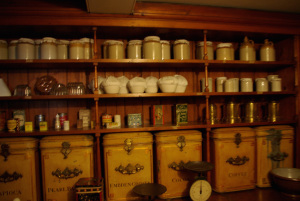
The housekeeper at Wimpole had a lovely room with lots of storage, including the storeroom pictured above. Our guide was wonderful as he explained the ins and outs of the lives of servants from the housekeeper to the butler to the steward.

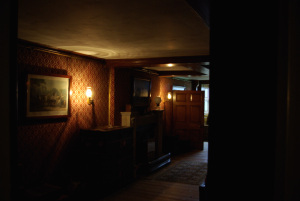
I cannot wait to return to see the upstairs of the house! We caught a glimpse or two up the stairs and it looked amazing!

First Trip to London
I feel I do not have to give you any of the history of London since it is perhaps one of the most noted cities in the world. We had waited a while, acclimating ourselves to a new country, before we attempted to tackle a large city. In the end, it was not as difficult as I had imagined it would be. I will say a good sat nav (GPS) is not a bad idea. I suppose the best way to describe everything is to take it as we did. We did not take any tours, but instead just learned to navigate our way around while we took in some of London’s most famous sites.
We parked at one of the outermost tube stations-not the most popular as the parking was atrocious-but instead took one of the next stations where the parking was ample. Almost everywhere is pay and display in England, which means you pay at a machine located somewhere in the lot, and then place the ticket on your dashboard. Every lot has a time limit, fortunately, ours gave us until 2am. We didn’t need nearly that much time.
Our two youngest children were free when riding the tube, so we purchased three day passes (somewhere around £23 = $35), which would take us anywhere we wished to go for the entire day. We then took the next train in to London. We did have to change to another tube line. It isn’t as difficult as it may seem. There are maps of the entire tube system on every train, and in the tunnels leading to the trains there are breakdowns of what direction takes you to what stops. The tube stations were busy, so I did not take photos. Sorry!
We decided before venturing into town that we wished to see the poppies at the Tower of London before they were picked up on November 11 (Armistice Day), so our first stop was Tower Hill. Apparently, all of England had the same idea! We were delayed on our approach to the Tower Hill tube station twice before finally having the ability to disembark. We were then funnelled through the station in a massive crush. We did not even have to scan our passes when we left the station. It was too crowded and the authorities had opened the gates to allow everyone off.
Tower of London is, of course, mentioned in gobs of literature and referenced in many stories. It originally dates back to 1066 when William the Conqueror established the Tower to keep the “hostile Londoners at bay.” In 1536, Anne Boleyn was beheaded on Tower Green. Elizabeth I was imprisoned within the Tower. And, lastly, in 1605, Guy Fawkes was tortured in the Tower after his failed attempt to assassinate James I and Parliament using gunpowder to blow up the parliament building. The tower is known for all of these things as well as being the current location where one can see the Crown Jewels.
The tower, for the 100th anniversary of World War I has an amazing installation piece called Blood Swept Land and Seas of Red created by the ceramic artist Paul Cummins. 888,246 ceramic poppies were slowly added to the moat around the tower – one for every British and colonial soldier killed in World War I. Poppies are what the English wear for Remembrance Day, which is a lot like the holiday of Veterans Day in the U.S. Each poppy for this exhibit was made by hand and set out by volunteers. Each has already been sold, and after November 11, will be shipped off to the people who purchased them.
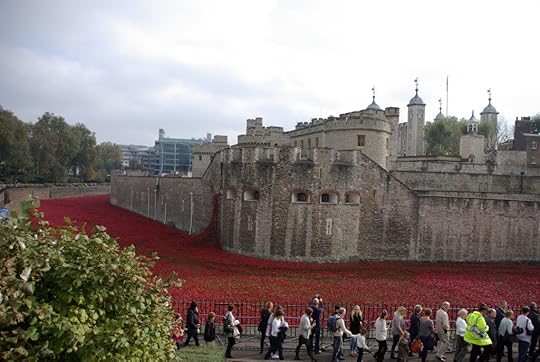
When you stand and take in exactly how many poppies there are, it is astounding. It is very humbling, and even my 9 year-old’s eyes bugged when she was told what each poppy represented.
The lines to tour the Tower were atrocious, so we decided to walk. We initially walked up to St. Katherine’s Dock, where we ate lunch. Then we backtracked to the Tower of London Bridge. We crossed the bridge to Southwark. From the bridge, you have a great view of the buildings along the Thames, and the Shard.

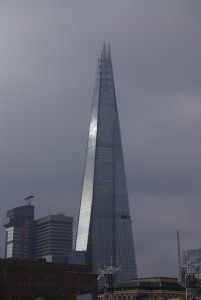
We continued along the Thames, passing a reproduction of the Golden Hinde, Sir Francis Drake’s ship that circumnavigated the globe, and Shakespeare’s Globe Theatre. The Globe is also a reproduction based on the 1599 and 1614 models of the site. The new Globe opened in 1997. We had been heading toward Westminster, but we forgot to turn toward a particular road we were supposed to take and stuck to the river front, happening upon the Millennium Bridge. This was the highlight of the day for my children. If you are a big Harry Potter fan, you will recognise this as the bridge the Death Eaters destroyed in the movie Half-Blood Prince. They all were very excited and insisted on crossing the Thames.


millennium Bridge crosses the Thames between the Tate Modern (which I completely missed!) and St. Paul’s Cathedral. I thought my children might be excited to see the cathedral from Mary Poppins, but they only reinforced my belief that I haven’t had them watch the movie enough. I was singing “Feed the birds, Tuppence a bag…” and they were telling me they didn’t remember the movie well enough. (*sigh*).
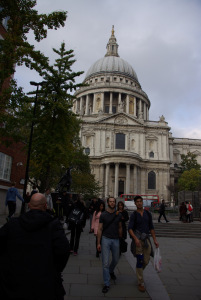
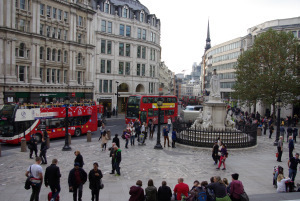
We did go inside the Cathedral briefly, but there is a tour and they do not allow photographs within the Cathedral. We hope to return to take the tour. The children had lost patience with walking by then, which is why we hunted down the nearest tube station to go to Westminster. It is really an incredible sight when you exit the station and immediately see Big Ben before you.
I studied the Parliament Building in a History of Architecture class my final semester in school. I was taken by the photos, and I was fascinated by it as we walked to see it. We had to go out on the bridge to really get a scope for the Gothic Revival building (My son must have been bored, because he took enjoyment in spitting in the Thames. *facepalm*). My husband is used to most of the gothic churches being built between 1200 and 1400, so I had to ask him when he thought the Parliament building was built. He was very incorrect.
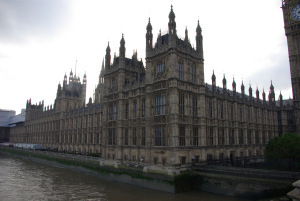

As we were taught, the government required a larger Parliament building than the one they were using, so in the process of deciding to build a new one also decided the new home of Parliament should be a distinctly “English” architecture. As a result, they dictated the design should be Gothic or Tudor, which they felt to be the most English forms. Charles Barry and Augustus Pugin were the architects, Pugin being responsible for the addition of Big Ben, an iconic symbol of England and London. Barry was supposedly looked at the big picture or larger details of the building, while Pugin had the eye for detail. I will say the detail is amazing when you stand on Westminster bridge and examine this building. This exacting eye had a price in that Pugin went insane before the completion of the building around 1870.
From the Parliament building, we began to walk. Stopping to sit outside of Westminster Abbey before venturing through St. James’ Park, which has a lovely walk along the pond. We walked past Buckingham Palace, and then up the road to Charing Cross Station where our day ended.
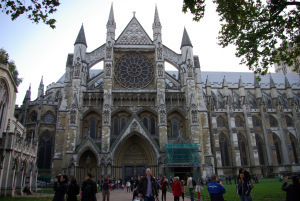


Fortunately, we were able to bypass the Tower Hill tube station on our way back to our car! I had been informed earlier by someone working in one of the tube stations that Tower Hill had been closed numerous time that day because they could not handle the crowds!
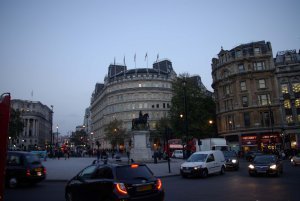
This roundabout made me glad we didn’t drive into London! I cringe to think of what parking would have entailed!
http://www.hrp.org.uk/TowerOfLondon/stories/timeline



